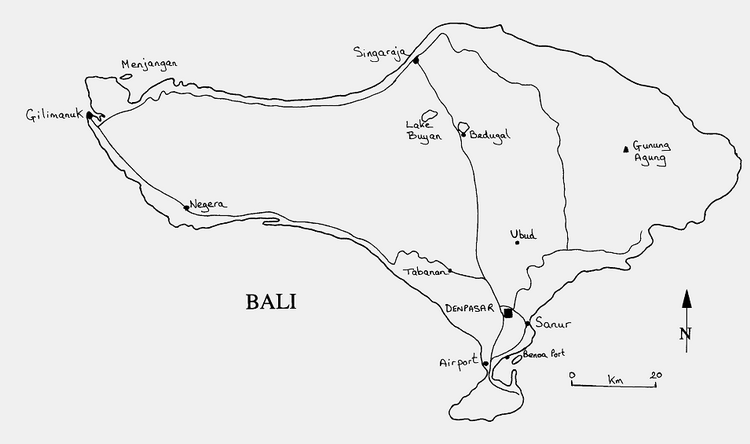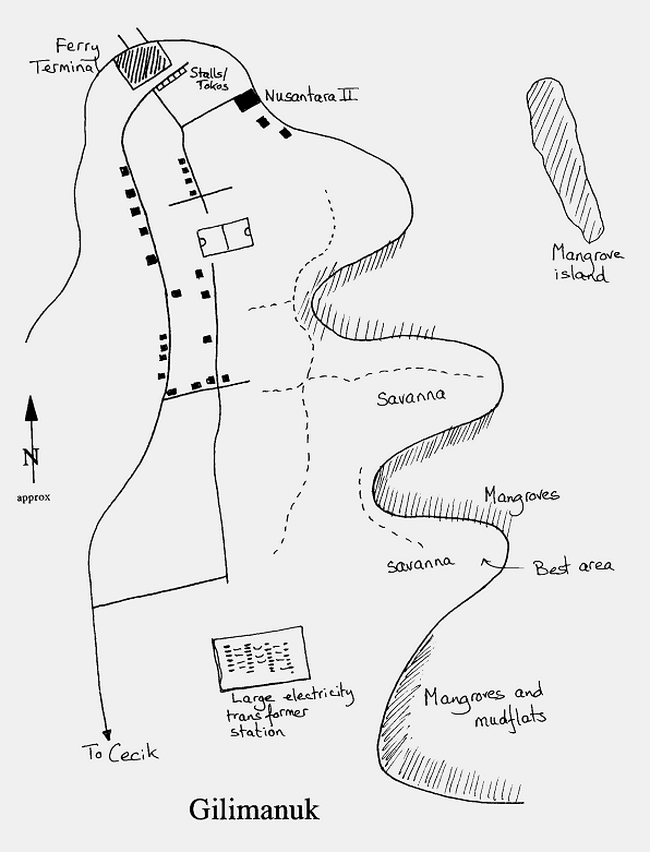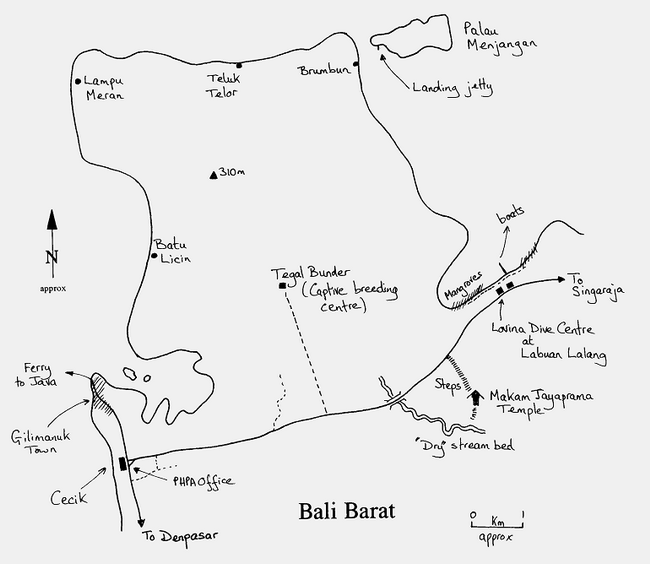Section 1 - Introduction, logistics, itinerary and general information.
Section 2 - Birding sites (Java - Bogor Botanical Garden).
Section 3 - Birding sites (Java - Gunung Gede and Cibodas).
Section 4 - Birding sites (Java - Carita, Indramayu, Pantai Song and Cangkring).
Section 5 - Birding sites (Java - Baluran, Pangandaran and Segara Anakan).
Section 6 - Birding sites (Bali - Gilimanuk and Bali Barat).
Section 7 - Birding sites (Bali - Bedugal, Ubud and Sanur).
Section 8 - Annotated checklist.
Bali
The atmosphere on Bali differs from Java in several ways. The pace of life seems less hectic, and the countryside and towns feel much less overcrowded. Being a major tourist destination, English is widely spoken. Getting around is easy, though finding bemos after dark is more problematic.

Gilimanuk
Gilimanuk makes a convenient base for a few days to visit the Bali-Barat National Park, and explore the northwestern tip of Bali. This area of Bali is rather dry, with much Acacia and savanna, and to many people resembles parts of Africa. Access is either directly from the Java-Bali ferry, or if coming from Denpasar there are through buses and bemos either direct or via the central highlands. I stayed at, and would recommend, the Nusantara II Homestay (12,000 Rp) close to the Bali-Java ferry terminal. Tea is available throughout the day, but not food. This is available at a number of small restaurants, shops and market stalls along the quay just 100 metres away. Unfortunately, the accommodation choice in Gilimanuk is rather limited; all places of the same basic standard and around the same price. One advantage of Nusantara II is that it is off the main road and hence quieter at night. All the other homestays are situated right on the main road and consequently suffer a constant stream of heavy trucks throughout the night as the ferry operates a 24 hour schedule. The 04h:00 prayer call from the mosque can also be avoided by staying at Nusandara II, which additionally provides instant access to the beach and nice views, at low tide, across the mud where Lesser Adjutant and Beach Thick-knee are seen.

Birding Gilimanuk Bay is well worthwhile - an area which includes the mangroves and mudflats of the bay with degraded Acacia scrub along the edge. Starting from Nusnatara II homestay walk eastward and southward along the beach, and bird the area as far as the large electrical power transformer station. The open grassy areas near the station are a regular spot for Oriental Plover during migration. Check the "mangrove island" directly opposite Nusantara II at low tide, as this is probably the best place to find Beach Thick-knee in the area - up to five birds are regularly present. Also scan the mangrove edges on the opposite side of the bay. Several pairs of Lesser Adjutant can usually be seen. Species of note that I saw were Orange-breasted Green-Pigeon, White-shouldered Tiller, Savanna Nightjar, Streaked Grass-Warbler, and Black-winged Starling.
Bali Barat National Park
The Bali Barat National Park is world famous amongst birders as the last refuge of the critically endangered Bali Starling, numbers of which continue to decline, with now only 25-27 birds remaining. In the late 1980s, BirdLife International was involved with the conservation and reintroduction programme. They however, withdrew from the project (reasons unclear?), and it is now run solely by the PHPA. Unfortunately, introduced birds have not proved to be viable. All have died from causes ranging from their inability to adapt to the harsh conditions (non-recognition of predators, poor ability to find water) and from continued trapping. The primary cause of the continued decline of the wild individuals is still cited as trapping, despite constant patrolling and wardening of the reserve. In an increased deterrent to would-be trappers some of the guards now carry automatic weapons.
The main PHPA office of Bali Barat National Park is at Cecik, 2-3 kilometres from Gilimanuk at the road junction of Denpasar and Singaraja. Procedures, arrangements and requirements for access to the Bali Starling site have changed many times over the years (see various trip reports). Note particularly that the information given in the Lonely Planet guide, that permits are issued from Labuan Lalang, is completely wrong. The Labuan Lalang office at the Lovina Dive Centre only deals with snorkelling and diving off Palau (island) Manjangan. Whilst it is possible to just turn up at the Cecik office, seek permission and make arrangements, I found it a considerable advantage to write to the director in advance, requesting permission and giving my proposed arrival date. As a consequence I was well received, permission already granted and a guide pre-assigned. It should be noted that only certain guides are authorised to accompany visitors to the starlings, so avoid making arrangements with freelance guides who may approach you in town or at Labuan Lalang. Permission to visit the starlings appears to be granted exclusively by the PHPA director, so if he is not around at the time of your visit you might have to wait a few days.
To see the Bali Starling it is necessary to visit the northern tip of the reserve around Teluk Telor, where the few remaining territories are found. The birds can usually, though not always, be seen as they fly to or from their roosting places. As you are usually viewing from a prominent hill top views are sometimes distant, so a scope is useful, though not essential as these large white blobs stick out well. Unusually, on my visit I was taken to Brumbun on the eastern side where a few birds had been roosting. I was lucky in seeing some birds during the afternoon, as in the evening none was observed going to roost. Although in theory it would be possible to walk the 12 kilometres from the main road to Teluk Telor it is both impractical, strenuous and not permitted. You therefore need to hire a boat from the PHPA office at Labuan Lalang which is relatively expensive, as a mini cartel operates whereby the boats (which hold up to 10 people) are only available at a fixed price of 15,000 Rp/hour (minimum 4 hours). Four hours is plenty - leaving 05:00 for a morning, or 15:00 for an evening, attempt. This time is also plenty for snorkelling as well as visiting Palau Manjangan to search for the Lemon-bellied White-eye and Beach Thick-knee. Depending on where the boat beaches it is a good idea to bring flip-flops for your feet as you may have to walk ashore over sand and dead coral.

Even from Labuan Lalang it is evident that much of the natural vegetation of Manjangan has been destroyed. Scrub on the central and eastern part of the island was destroyed by a fire some years ago. However, natural vegetation still exists on the western end of the island, and the Lemon-bellied White-Eye is still found in reasonable numbers. We saw two individuals the heat of the day in the beach scrub about 100 metres along the concrete path which runs from the landing jetty on the western end.
The Bali Starling captive breeding project is located, inside the reserve, at Tegal Bundar. As with other areas of the reserve, permission to visit must be obtained from the PHPA office in Cecik. If you are lucky with the Bali Starling and/or have more time, the excellent dry forest of other areas of the reserve is well worth exploring, but requires the services of a guide to access. Possibilities include Javan Cuckooshrike, Fulvous-breasted Jungle-Flycatcher, Javan Kingfisher, and Banded Pitta. One good spot is the dry river bed behind the Malam Jayaprana temple. The temple, along the main road a few kilometres before Labuan Lalang, is open to the public (1,000 Rp) and accessed via a long series of concrete steps.
Species recorded from Bali-Barat area: This list includes both the reserve proper and the area around Gilimanuk. As the absolute status of many of these species is unclear, only an indication of rarer or more common species is given.
Great Frigatebird 1 |
House Swift |
Section 1 - Introduction, logistics, itinerary and general information.
Section 2 - Birding sites (Java - Bogor Botanical Garden).
Section 3 - Birding sites (Java - Gunung Gede and Cibodas).
Section 4 - Birding sites (Java - Carita, Indramayu, Pantai Song and Cangkring).
Section 5 - Birding sites (Java - Baluran, Pangandaran and Segara Anakan).
Section 6 - Birding sites (Bali - Gilimanuk and Bali Barat).
Section 7 - Birding sites (Bali - Bedugal, Ubud and Sanur).
Section 8 - Annotated checklist.
